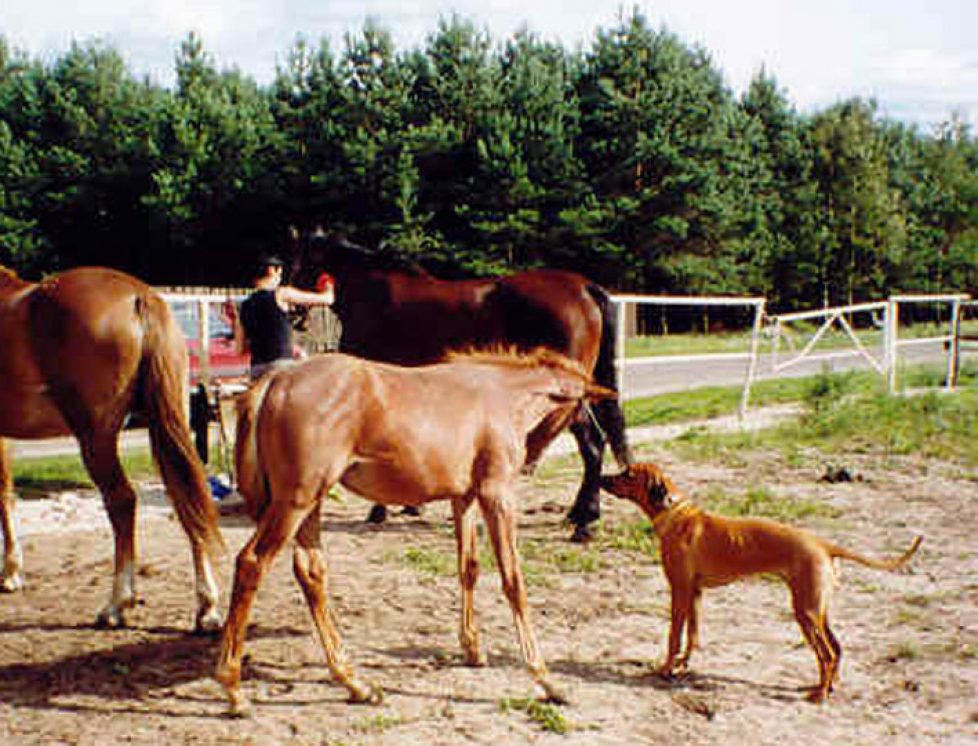
Breed standard of Rhodesian Ridgeback with comments of Major Hawley and judge Janet Parker (co-author of book THE COMPLETE RHODESIAN RIDGEBACK. The breed standard).
General appearance
A well coupled dog is visualized. The emphasis is on utility combined with handsomeness, abundant substance stripped of all ballast. The Breed Standard gives a good outline of the Ridgeback. However, the breed has increased in popularity over the years, and inevitably, this has produced considerable variation in type ? from the heavy-headed Mastiff-type to the small, light-boned rabbit-type. The Ridgeback is first and foremost a hunting dog, who should be strong and muscular, but the same time it should be lithe and active, and capable of achieving a fast gallop and a swift change of direction. The heavier type of Mastiff type would not be capable to doing this. When you are judging the breed, you should look at each dog and recall that these were the animals that were used to hunt and bay the lions. The question you should ask yourself is ; ?Is this dog capable of carrying out the job is was bred for??
Characteristic
Characteristic for the breed is the ridge formatted by the hair grown backwards.It should be well declined , symmetrical , commencing behind the shoulders , tapering and symmetrical to the haunch. It should contain two symmetrical crowns, directly opposite each other. The crowns should be one third or less of total length of ridge. Desirable ridge width ? 5 cm. The ridge is what makes a Rhodesian Ridgeback stand out from any other breed of dog ? its importance cannot be over-estimated. A Ridgeback without a ridge would be like having a Dalmatian without the spots. The Breed Standard stipulates in some details the length, width and position of ridge, and short ridges or run outs (a variation of width) will be considered as faults.
When the standard was originally formulated ?fiddle? ridge were permissible. In some of the older types the various cow licks on the back resulting from irregular placement of a number of crowns resulted untidy ridges. Nature has found it is possible to give us a high percentage of clear, beautiful ridges. The ridge must be maintained. It is not yet so fixed as to be constant feature. Ridgeless pups may occur in most families, but occurrence of such pups is diminishing. Whole litters are born with beatiful ridges. Their definition can best be seen shortly after birth, whilst the coat is still moist and lying close to the skin. For the next weeks the coat is fluffy and the ridge is not so clearly defined. By the time they are due to wean and thence onward it can be xlearly seen. The ridge remains in the same proportion to the body when it grows up and we must disregard stories about sprouting to its full glory when the dog matures.
Temperament
Affectionate and intelligent, vary from the strangers, but without any sign of aggression or shyness. Everyone who has owned a ridgeback will enthuse about the breed?s temperament. It is an outstanding family dog ? loyal, affectionate and protective. The Ridgeback has strong guarding instincts, but this should never be expressed as uncontrolled aggression. This is a dog who will accept its owner as pack leader, and although it is wary of strangers, it will accept owner?s assessment and will be friendly and welcoming if the stranger is properly introduced.
Head and skull
This is one of the areas where the Breed Standard is open for the interpretation. We prefer the powerfull maskuline, impressive head on the male and the females should look pretty and feminine. the head should be well balanced. A heave head will be penalised , so will the snipey and short muzzle. The stop should be prononuced , the skull must be flat. A round skull, jowly cheeks are both regarded as faults.
The only correct bite is the scissor bite, the overshot or undershot would be penalised and the the dog with not correct bite shouldn`t be used for breeding. Dogs should have 42 teeth - 20 above and 22 below .
The best heads are those in which the lenght of muzzle most nearly equals that of the head measured from occiput to a line drawn through the centre of the eyes. A black muzzles are correct so long as it does not continue over the eyes so as to form the mask.
Eyes
The eyes must harmonise with dog`s coat colour. it is therefore permissible to have amber eyes in a brown or livernosed dog. But black eyed dog should have dark eyes. They should be round in shape , almond shape eyes will be penalised. The expression should be bright , alert and inteligent.
Ears
Black ears are not correct , but they may be darker than the rest of the coat. They should be carried closed to the head and set rather high. The judge will penalise ears that are set either too high or too low, or if they are set on the top of the head.
Neck
The Ridgeback should have clean neck of the fair lenght. It should appear muscular , but flexible with the arched topline. If is too long or too short and thick , the dog would be faulted. Throatiness , which means too much loose skin around the throat would be also penalised.
In the most represenative specimen of the breed the neck is fairly long and flexible. with elegant arched topline , carrying the head high. In a very well proportioned dog the point above the shoulder blades ahould be the highest point of the back line, never lower than the hindquarters.
Forequarters
The legs should have good bone , not too heavy or too fine boned. When the dog is viewed from the side it should be appear broader than it viewed from the front. The type which is to heavy boned or too light will be faulted. The dog must be not wide or too narrow and it should not be out of the elbow. These fault will affect the dog`s movement.
Body
A fully grown mature dog should have a good depth of the brisket reaching down to the elbow. The lenght of the body between the shoulder and hindquarters should be slightly longer that the height of the dog from the withers to the ground level.
The brisket of the mature dog should reach well down to the elbows , so that the depth of the chest from the top of the withers to bottom line of the brisket , taken behind the elbow , approximates that the distance of there to the ground level.
Hindquarters
The Ridgeback should be agile dog , otherwise it would be not effective as the hunter.Faults in the hindquarters relate directly to the a dog`s speed and agility , and therefore a judge will penalise hocks that are set too high and cow hooks, which are set too close behind. A weak second thight and stiffles that are too straight or over-angulated would be penalised. If the dog ppears the musculebound , this will be also considered contrary to the Breed Standard.
Feet
Flat feet are becoming quite common , occasionaly we have seen the hare feet in the ring, which is serious fault. Regular road-walking will usually keep feet in good order, it is generally the dog who is kept on soft ground that have problem such a splayed feet and nails that are too long .
No matter how good the dog is , if he has not good legs and feet , buy him a pair of roller skates , but do not breed him. C.H.Edmonds ( 1923) says :" They must have the best feet, with the pads that stand up to any amount of wear, as they will have to work day after day ".
Tail
The tail helps to balance a dog when it is running and turning at speed. The Ridgeback should carry its tails almost the level with its back. It should never be curled over.
The "slight curve upwards" as stated , the tails drops naturally and finishes up with a sweep backwards. The tail adds the finishing touch to the graceful lines, and should not be understimate.
Gait/Movement
The Ridgeback`s movement was described by original Breed Standard as being similar to the Foxhound movement. The present description says : "Straight forward, free and active". A Ridgeback should stride out with the free and easy movement , with the powerful drive coming from the hindquarters. The dog should be not out of at elbow, i.e. the elbow`s moving out whenit is on move instead of staying close to the body. It should not high-step like trotting pony , or display a plaiting movement with the front legs crossing , or crabbing, where the dog moves to one side. When dog moves the judge can assess the hocks and check that they are not close together or too wide apart.
Coat
The Ridgeback comes from a hot country , and this is reflected in it short, dense coat. However the Ridgebakcs in colder countries tend to develop the thicker coat. This should be not faulted as long the texture is neither wooly or silky.
Colour
The colour "wheaten" is open to the interpretation, but we take it most literal , i.e. the colour that describes the field of ripening wheat. Grey ghost, silvers, weimaraner colours and black and tan should be sold as a pets on the undersatnding that they will not be used for breeding. The novice breeder may be misled when seeing pups at birth. It may appear black , but if you look closely at the colour on the top of the head , this will give a good indication of the true colour. Little white is permissible , but white above toes is not desirable.
The eartwhile brindles and mouse colours have long since disappeared . An occassional pale one turns up. Such light wheaten should not be bred together . On the other hand there is some tendency to favour very dark dogs which is equally undesirable to bred together. As regards to the white , it is fortunate that the standard has not entirely condemn the white markings , but attempts to reduce it to the minimum.
Size
The Breed Standard allows for considerable variation is size : the males may be from 63 cm to 68 cm( 25-27 inch) and females from 61 cm to 66 cm ( 24-26 inch) . The measurement should be taken from the withers ( the highest point of the shoulder blades) to the ground level. The males should weight 36 kg and the females 32 with permissible variation of 2,5 kg above or below these weights.
Scale of points
These are not included as part of Standard but it is useful guide for judges , breeders and exhibitors alike.
While the points of this scale are indicators of the importance attached to each of various features , in practise the judgeing in the ring is done by comparisions with the other dogs and not score cards. A dog is judged as a unit and i is up to the judge to pay the attention to the details in making its assessment.
